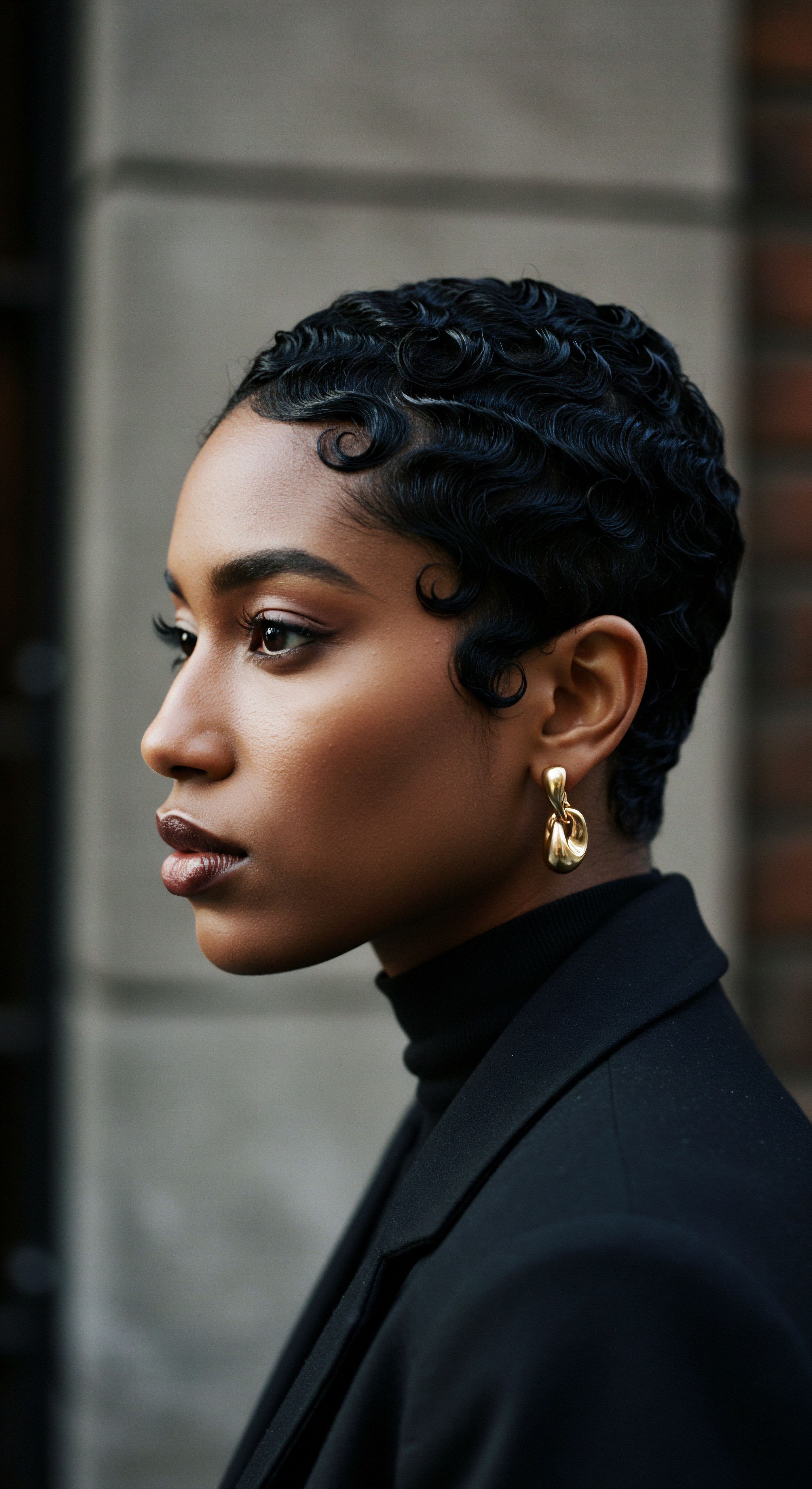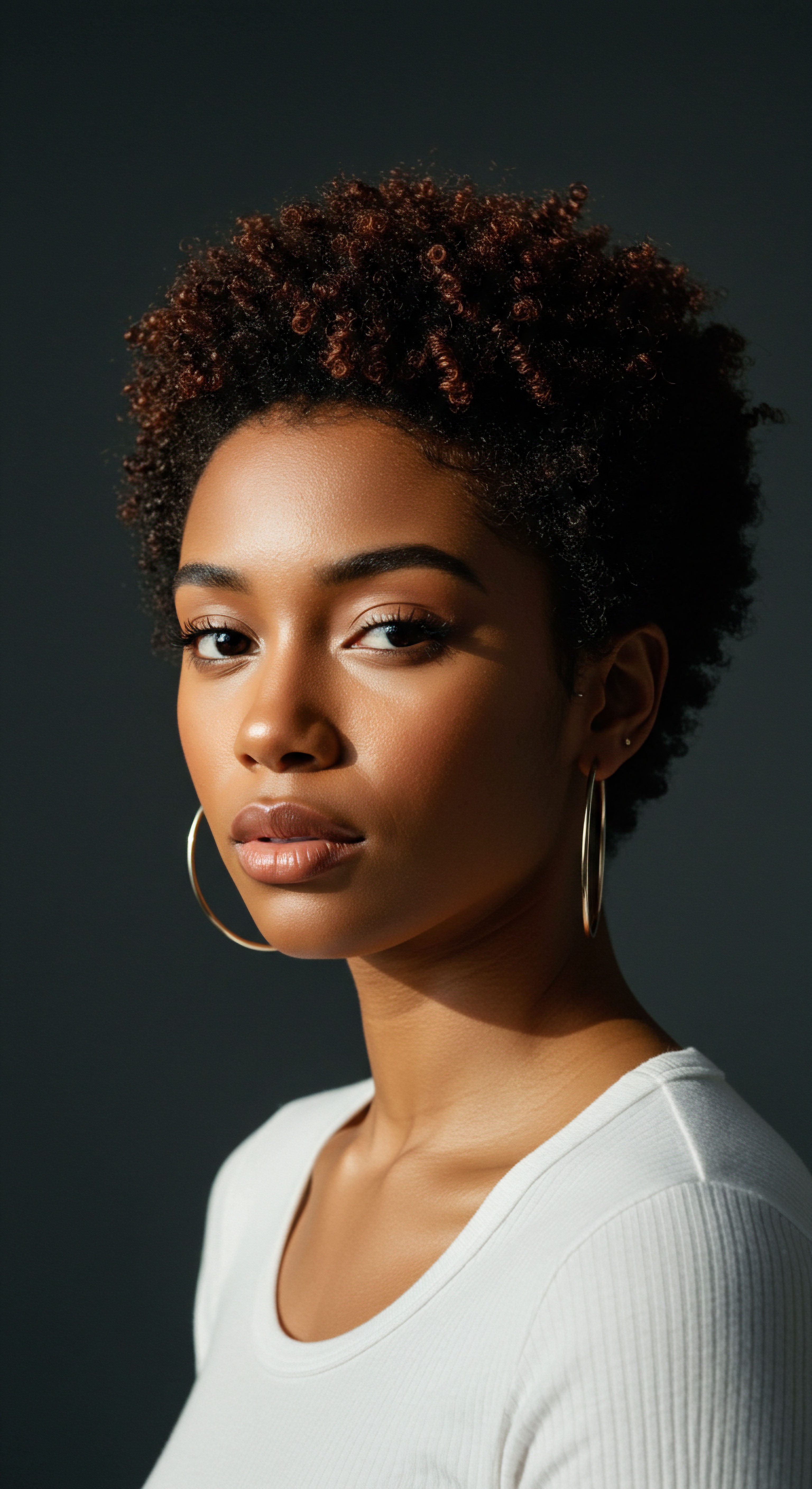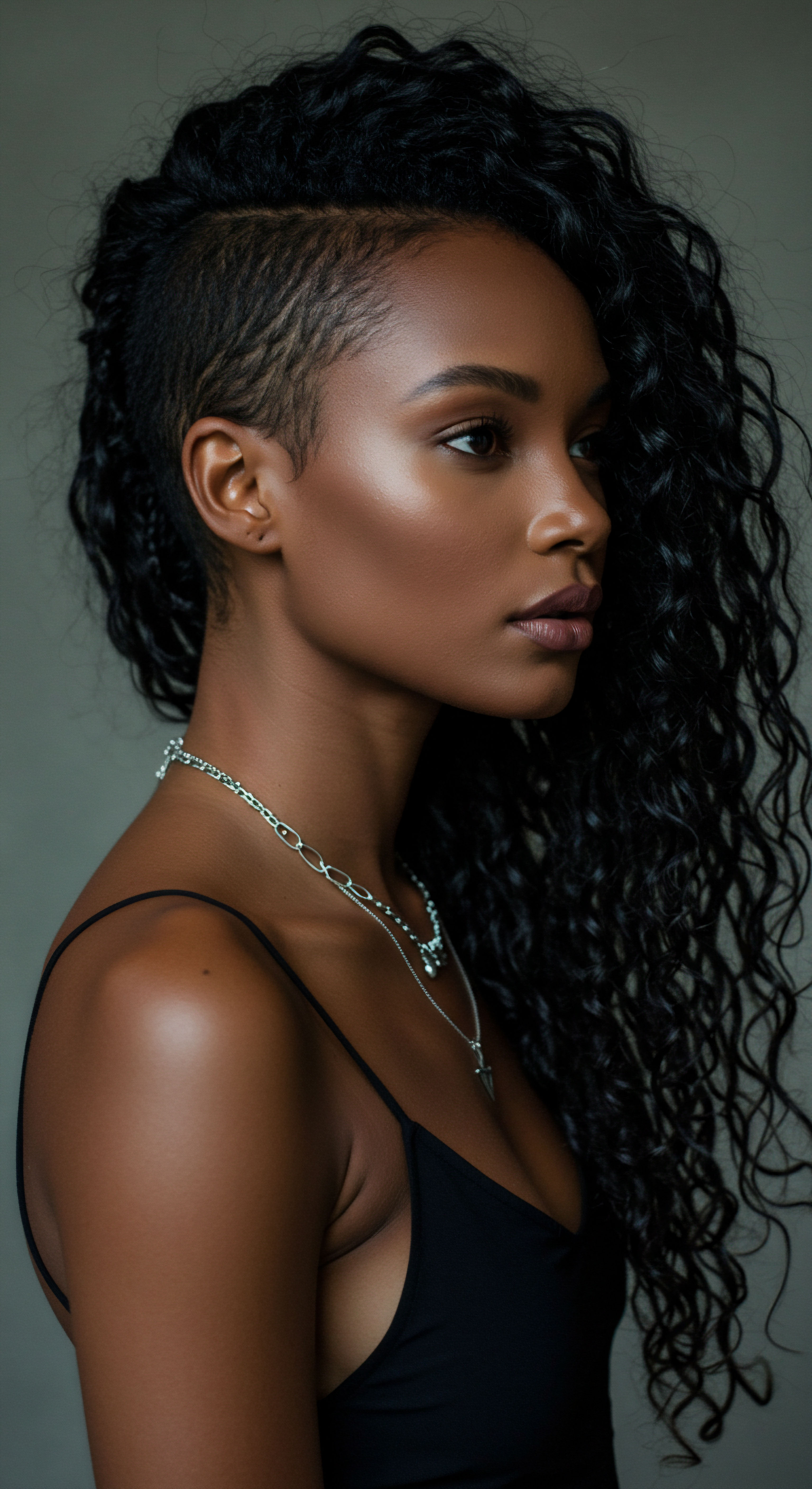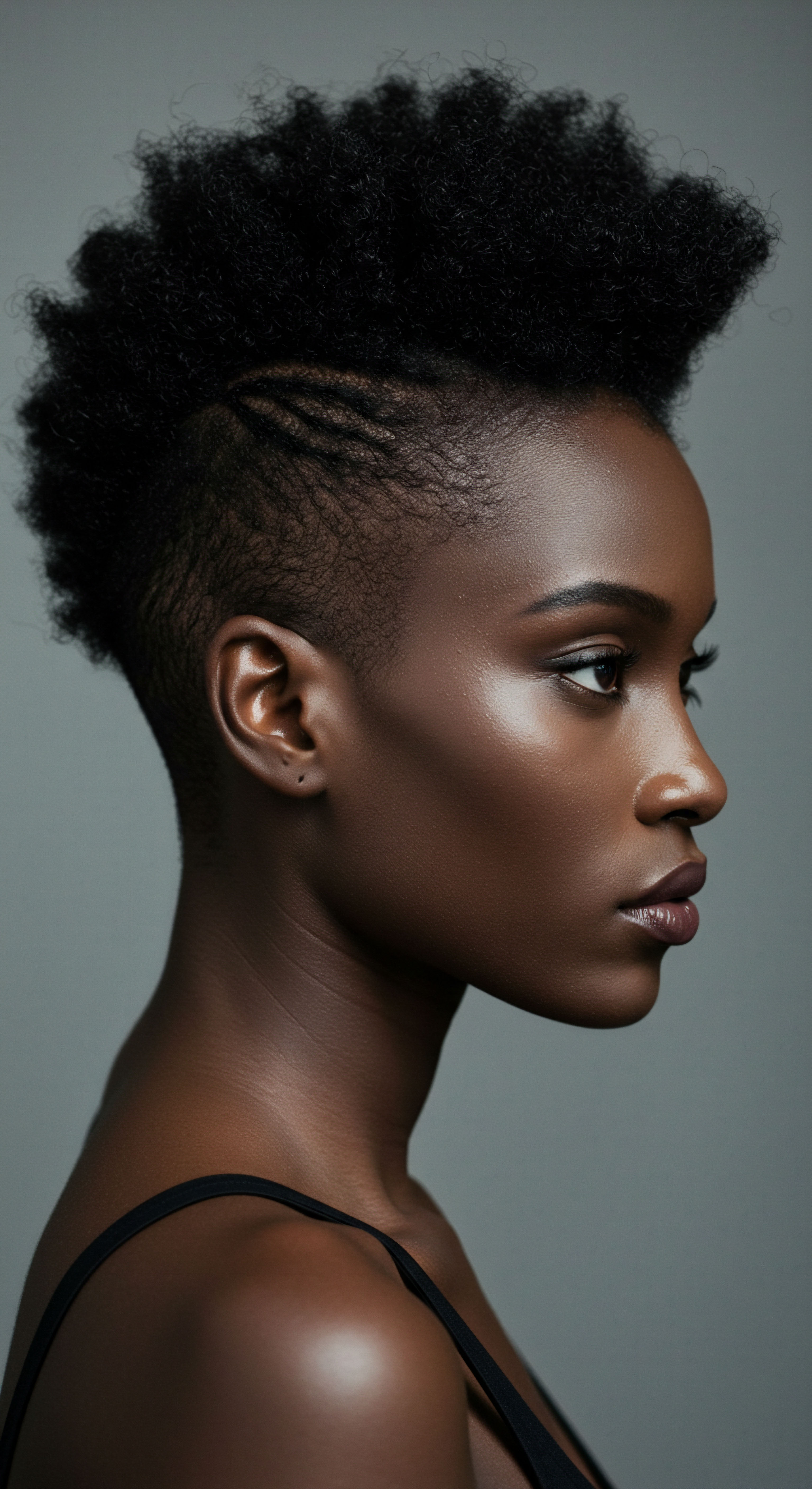
Roots
The quiet hours of night, often viewed as a mere pause in our waking lives, hold a profound, often overlooked, influence on the very strands that crown our heads. For those with textured hair, this nocturnal period is not simply a time for rest; it is a canvas upon which the destiny of our coils and curls can be gently guided or, conversely, inadvertently challenged. The inquiry into whether specific sleep habits possess the power to truly safeguard hair against breakage and thinning reaches far beyond superficial concerns, delving into the very cellular rhythms and historical practices that shape our hair’s resilience. We begin our exploration at the elemental level, seeking to understand the hair itself and its intricate dance with the body’s natural cycles, especially as the world outside softens into slumber.

Hair Anatomy and Physiology Specific to Textured Hair
To appreciate how sleep habits can shield textured hair, a comprehension of its unique architecture is helpful. Unlike straight hair, which typically emerges from a round follicle, textured hair springs from an oval-shaped follicle. The flatter the oval, the tighter the curl, resulting in the distinct coils and z-patterns that characterize Black and mixed-race hair. This follicular shape dictates the hair shaft’s helical growth, leading to numerous bends and twists along its length.
These natural curves, while beautiful, represent points of structural vulnerability. At each curve, the cuticle, the hair’s outermost protective layer composed of overlapping scales, tends to lift slightly. This elevated cuticle renders textured hair more susceptible to external friction and moisture loss. When these delicate scales are raised, the hair’s inner cortex, which holds its strength and elasticity, becomes exposed to damage. The natural oil produced by the scalp’s sebaceous glands also struggles to travel down the spiraling shaft, often leaving textured hair drier than other hair types, thereby increasing its fragility.
The unique structure of textured hair, with its natural curves and lifted cuticles, renders it particularly susceptible to damage from external forces.
Understanding these inherent characteristics allows us to appreciate the heightened need for protective measures, particularly during sleep when mechanical stressors can be unknowingly at play. The way we lay our heads, the surfaces our hair encounters, and the internal physiological processes occurring during rest all contribute to the well-being or distress of these beautifully coiling strands. A thoughtful approach to nighttime care becomes not a luxury, but a fundamental act of preservation for textured hair.

Hair Growth Cycles and Influencing Factors
Our hair follows a cyclical journey of growth, transition, and rest, a rhythm profoundly influenced by our body’s internal clock. This cycle consists of three primary phases ❉ anagen, catagen, and telogen. The Anagen Phase represents the active growth period, where hair follicles are vigorously producing new hair. This can last for several years.
Following this is the brief Catagen Phase, a transitional stage where growth slows and the hair follicle shrinks. Lastly, the Telogen Phase is a resting period, during which the hair ceases growth and eventually sheds, making way for new growth.
Sleep plays a quiet, yet significant, role in orchestrating these phases. During deep sleep, the body engages in critical repair and regeneration, processes that extend to the hair follicles. Blood flow to the scalp increases, delivering essential oxygen and nutrients to these microscopic powerhouses. Hormones, including growth hormone and melatonin, rise during these restorative hours, both playing a part in regulating the hair growth cycle.
Disruptions to this nocturnal rhythm can throw the hair cycle off balance. Poor sleep quality or insufficient rest can shorten the active anagen phase, leading to slower growth or premature shedding. Elevated stress hormones, such as cortisol, a common consequence of sleep deprivation, can prematurely push hair follicles into the resting telogen phase, resulting in increased hair fall. This connection underscores how the seemingly simple act of sleeping carries profound implications for the ongoing vitality of our hair.
Consider the delicate interplay between sleep and the hair follicle’s intrinsic timekeeping. Research indicates that hair follicles themselves possess an autonomous circadian clock, a biological rhythm that aligns with the body’s broader sleep-wake cycle. A study on cashmere goats, for example, highlighted how melatonin, a hormone associated with sleep, directly influences hair follicle cycling, synchronizing the anagen, catagen, and telogen phases with seasonal photoperiod changes. This observation suggests that the hair’s own biological clock responds to environmental light cues and internal hormonal signals linked to sleep.
When our sleep patterns become irregular, the hair follicle’s internal timing mechanism can become desynchronized, potentially affecting its ability to sustain healthy growth and regeneration. The subtle yet profound impact of a well-regulated sleep schedule extends beyond mechanical protection, reaching into the very genetic expression and cellular activities that determine hair health.

Ritual
Stepping beyond the fundamental understanding of hair’s inner workings, we arrive at the practical wisdom, the daily and nightly practices that shape our hair’s external reality. The desire for vibrant, resilient strands often leads us to consider products and treatments, yet a potent ally resides in the quiet hours of rest. How we prepare our hair for slumber, the surfaces it touches, and the very air around it can significantly alter its condition. This section seeks to illuminate the applied science of nighttime care, transforming routine into a deliberate ritual of preservation for textured hair.

The Nighttime Sanctuary ❉ Essential Sleep Protection and Bonnet Wisdom
The act of sleeping, while restorative for the body, can present a surprising challenge to hair, especially textured hair. The constant friction against bedding materials like cotton can abrade the delicate cuticle layer, leading to frizz, tangles, and ultimately, breakage. This mechanical stress is particularly impactful on coily and curly strands, which possess more points of contact with surfaces.
To mitigate this, creating a ‘nighttime sanctuary’ for hair becomes a sensible practice. This involves choosing materials that reduce friction and implementing protective styles.
Silk and Satin Pillowcases ❉ These smooth surfaces allow hair to glide rather than snag, significantly reducing friction. This lessens the likelihood of cuticle damage, preserving moisture and minimizing tangles.
Hair Bonnets and Scarves ❉ A long-standing tradition in many cultures, particularly within the Black community, bonnets and scarves made of silk or satin offer an additional layer of protection. They encase the hair, shielding it from direct contact with bedding and the drying effects of circulating air.
Consider the practical advantages of these coverings:
- Minimizing Friction ❉ The smooth material of a bonnet or scarf creates a barrier, allowing hair to move freely without rubbing against abrasive fabrics.
- Retaining Moisture ❉ Textured hair is prone to dryness. Enclosing the hair helps to trap natural oils and applied products, keeping strands hydrated overnight.
- Preserving Styles ❉ For those who spend time styling their hair, a bonnet can help maintain definition, reduce frizz, and extend the life of a hairstyle, lessening the need for daily manipulation.
- Preventing Tangles ❉ Loose hair can tangle easily during sleep. A bonnet keeps strands contained, reducing knotting and making detangling gentler in the morning.
The choice between a bonnet, scarf, or pillowcase often comes down to personal comfort and hair length/density. Many find a combination works best, such as a silk pillowcase paired with a loose protective style under a bonnet. The ritual of preparing hair for sleep becomes a mindful act, a small investment in its long-term vitality.

Does the Type of Sleep Covering Truly Make a Difference?
The material against which hair rests during sleep profoundly impacts its condition. Cotton, a common pillowcase material, possesses a rougher surface and absorbent qualities. As we shift during the night, cotton fibers create friction, which can lift the delicate cuticle scales on each hair strand.
This mechanical agitation leads to frizz, tangles, and ultimately, breakage. Furthermore, cotton can absorb moisture from the hair, leaving it drier and more brittle by morning.
In stark contrast, silk and satin offer a smooth, low-friction surface. Hair glides effortlessly across these materials, minimizing the abrasive action on the cuticle. This gentle contact helps keep the cuticle scales flat, preserving the hair’s natural sheen and reducing the likelihood of breakage.
Additionally, silk and satin are less absorbent than cotton, meaning they allow hair to retain its natural moisture and any applied products. This is especially beneficial for textured hair, which naturally tends towards dryness.
| Material Cotton |
| Surface Texture Rough, fibrous |
| Moisture Absorption High |
| Impact on Hair Increased friction, frizz, tangles, moisture loss, breakage |
| Material Silk/Satin |
| Surface Texture Smooth, slippery |
| Moisture Absorption Low |
| Impact on Hair Reduced friction, preserved moisture, minimized tangles, less breakage |
| Material Opting for silk or satin materials for pillowcases and hair coverings provides a gentler environment for hair during sleep. |
The choice of sleep covering is not merely about comfort; it is a deliberate strategy to shield hair from the nightly rigors of movement and environmental factors. By consciously selecting silk or satin, individuals can create a protective cocoon for their hair, contributing significantly to its strength and overall health.

Building Personalized Textured Hair Regimens
A well-rounded hair care regimen extends beyond wash days and styling sessions, reaching into the quiet hours of the night. For textured hair, which often requires specific attention to moisture and gentle handling, nighttime habits are integral to overall health. A personalized regimen considers the unique needs of one’s hair type and how sleep can either support or hinder its vitality. The objective is to minimize friction, maintain hydration, and support the hair’s natural cycles during rest.
Elements to consider for a nighttime regimen:
- Moisture Application ❉ Before bed, apply a leave-in conditioner or a light hair oil to dry or slightly damp hair. This helps to seal in moisture, which is particularly beneficial for textured hair prone to dryness.
- Protective Styling ❉ Loose twists, braids, or a pineapple bun (a high, loose ponytail) can keep hair contained, reducing tangles and friction against bedding. These styles prevent strands from rubbing against each other or external surfaces.
- Scalp Care ❉ Gentle scalp massages before sleep can stimulate blood flow to the hair follicles, delivering nutrients and oxygen. This can be combined with a light, non-comedogenic scalp oil if desired.
The continuity of care from day to night establishes a supportive environment for hair growth and resilience. A regimen that acknowledges the unique demands of textured hair during sleep helps to reinforce its strength and beauty, preparing it for the day ahead. This deliberate attention transforms nighttime into a period of active restoration for the hair.
A holistic hair care regimen recognizes the quiet hours of sleep as a critical time for hair health, emphasizing protection and moisture.

Relay
Having considered the fundamental anatomy of hair and the practical rituals of nighttime protection, we now transition to a more expansive understanding, one that connects sleep habits to the intricate biological and cultural currents influencing hair health. This deeper exploration moves beyond surface-level mechanics, delving into the physiological responses to sleep quality and the historical resonance of nighttime hair care. The inquiry broadens, inviting us to consider how the unseen processes of the body and the enduring wisdom of generations shape our hair’s vitality.

Can Disruptions to Sleep Cycles Lead to Hair Loss?
The connection between sleep and hair health extends far beyond mere mechanical protection; it delves into the very biochemistry and hormonal balance that govern our bodies. Sleep is not a passive state, but an active period of repair, regeneration, and hormonal regulation. When sleep patterns are consistently disrupted, a cascade of physiological responses can directly impact the hair follicle, potentially leading to increased shedding or reduced growth.
One of the primary biological links lies in the body’s stress response system. Insufficient or poor-quality sleep can elevate levels of cortisol, often referred to as the stress hormone. Chronically high cortisol levels are linked to a condition known as Telogen Effluvium, where a significant number of hair follicles prematurely shift from the active growth (anagen) phase into the resting (telogen) phase. This results in widespread hair shedding, often noticeable several months after a period of prolonged stress or sleep disruption.
Beyond stress hormones, sleep also plays a role in regulating other vital hormones that influence hair growth. Melatonin, primarily known for regulating sleep-wake cycles, also possesses antioxidant properties and appears to have a direct impact on hair follicle function. Research indicates that melatonin receptors are present in human hair follicles, and topical application of melatonin has shown promise in promoting hair growth and density in certain types of alopecia.
Conversely, reduced melatonin levels due to sleep deprivation could compromise hair follicle health. Additionally, sleep affects the balance of hormones such as estrogen and testosterone, both of which play a part in the hair cycle.
Blood circulation to the scalp also sees a boost during deep sleep, delivering oxygen and essential nutrients necessary for robust hair growth. When sleep is inadequate, this circulatory support may diminish, depriving hair follicles of the nourishment they require to remain strong and active. This reduced blood flow can weaken hair strands, making them more prone to breakage and slowing overall growth.
The immune system, too, finds its restorative balance during sleep. A weakened immune system, a consequence of chronic sleep deprivation, can lead to inflammation around hair follicles, further impeding their normal function and potentially exacerbating conditions like alopecia areata, an autoimmune hair loss disorder.
A fascinating, though perhaps less commonly discussed, aspect of sleep’s biological sway over hair involves the hair follicle’s own internal clock. Hair follicles exhibit circadian rhythms, meaning their cellular activities, including proliferation and differentiation, follow a roughly 24-hour cycle. Disruptions to this localized circadian clock, often caused by irregular sleep schedules or shift work, can desynchronize the hair growth cycle. A study on female shift workers found that chronic circadian dysregulation affected the expression of key circadian genes (PER1 and BMAL1) in keratinocytes and dermal papilla stem cells isolated from hair follicles, leading to a loss of clonogenic potential in these hair precursor cells.
This suggests that prolonged disruption of the body’s natural sleep-wake rhythm can directly impair the regenerative properties of hair follicles at a cellular level, making them less capable of sustaining growth and recovery. This physiological truth underpins the profound biological connection between our sleep habits and the very resilience of our hair.

Cultural Significance of Nighttime Hair Practices
The act of preparing hair for sleep extends beyond modern scientific understanding, finding deep roots in cultural traditions across the globe, particularly within communities with textured hair. For centuries, nighttime hair rituals have served not only a practical purpose of preservation but also held symbolic meaning, reflecting heritage, identity, and self-care.
In many African and African American communities, the practice of covering hair at night with bonnets, scarves, or headwraps is a cherished tradition passed down through generations. These coverings, often made of silk or satin, are practical tools to shield delicate textured strands from friction, maintain moisture, and preserve intricate hairstyles. Beyond utility, however, these rituals embody a profound connection to ancestral knowledge and a celebration of natural beauty. The bonnet, in particular, carries a complex history, evolving from a symbol of grandeur in European societies to a tool of subjugation during enslavement, and ultimately, a powerful emblem of Black resilience, cultural expression, and self-sovereignty.
For instance, historical accounts show that during enslavement, laws in places like Louisiana (the Tignon Law) compelled Black women to cover their hair, an attempt to strip them of their adornment and social standing. Yet, these coverings became canvases for creative expression, with women decorating them with vibrant fabrics and jewels, transforming an oppressive measure into a statement of identity and resistance. Post-slavery, the bonnet continued its role in preserving textured hair, becoming a purposeful tool in the burgeoning Black hair care industry pioneered by figures like Madame C.J. Walker.
Nighttime hair rituals, especially the use of bonnets and scarves, hold deep cultural significance, symbolizing heritage, resilience, and self-care for textured hair.
Beyond head coverings, other cultural practices have centered on nighttime hair care. In some Indian traditions, for example, braiding hair before sleep, often accompanied by scalp massages and oil applications, is a routine passed from mothers to daughters. This practice protects the strands from tangles and breakage while promoting scalp health through increased blood flow.
Such customs underscore a universal understanding that the hours of rest are opportune for nurturing hair, not just physically, but also as an act of self-love and continuity with one’s past. These traditions highlight that the care of hair during sleep is a shared human experience, albeit expressed through diverse and culturally rich practices.

How Does Sleep Position Impact Hair Health?
While often overlooked, the position one assumes during sleep can contribute to the mechanical stress experienced by hair, potentially leading to breakage and thinning over time. The prolonged pressure and friction between hair and the sleeping surface can cause damage, particularly for those with vulnerable hair types like textured strands.
Side Sleeping ❉ Resting consistently on one side can create concentrated pressure and friction on the hair and scalp in that area. This can lead to increased breakage on the favored side, as the hair is repeatedly compressed and rubbed against the pillow. Over time, this localized stress may result in noticeable thinning or breakage patterns.
Stomach Sleeping ❉ Sleeping face down often means the hair is tucked underneath the head or body, leading to more widespread friction and compression. This position can exacerbate tangling and breakage, especially for longer hair that might be trapped.
Back Sleeping ❉ Generally considered the most hair-friendly position, sleeping on one’s back minimizes direct contact and friction with the pillow, as the weight of the head is more evenly distributed. This reduces mechanical stress on the hair strands.
The choice of sleep position, while often subconscious, can be gently adjusted to support hair health. Alternating sleeping sides, if comfortable, can help distribute pressure more evenly. Pairing this awareness with the use of smooth pillowcases or hair coverings further mitigates the potential for friction-induced damage, allowing hair to rest undisturbed through the night. This mindful consideration of how we position ourselves during sleep adds another layer to a comprehensive hair protection strategy.

Reflection
As the quiet of night descends, a gentle promise unfolds for our hair. The journey through anatomy, ritual, and the deeper biological and cultural currents reveals a profound truth ❉ sleep, in its delicate complexity, holds a significant key to the resilience and vibrancy of our strands. It is a time when the body quietly tends to its regenerative tasks, a period when conscious choices in protection and care can yield lasting benefits.
From the microscopic dance of circadian rhythms within each follicle to the timeless wisdom embedded in cultural practices of hair covering, the nighttime hours are not merely a pause, but an active participant in our hair’s story. May we approach these hours with the gentle wisdom they invite, allowing our hair to truly rest, regenerate, and flourish in the soft embrace of the night.

References
- Harima, M. Sato, K. & Miyamoto, T. (2020). Circadian Rhythm and Hair Follicle Cycling. Journal of Investigative Dermatology Symposium Proceedings, 20(1), S12-S15.
- Fischer, T. W. Burmeister, G. Schmidt, H. W. & Elsner, P. (2004). Melatonin increases anagen hair rate in women with androgenetic alopecia or diffuse alopecia ❉ results of a pilot randomized controlled trial. British Journal of Dermatology, 150(2), 341-345.
- Fischer, T. W. Trüeb, R. M. Hänggi, G. Innocenti, M. & Elsner, P. (2012). Topical melatonin for treatment of androgenetic alopecia. International Journal of Trichology, 4(4), 236-245.
- Milani, M. & Fischer, T. W. (2013). Melatonin and hair physiology ❉ reasons and clinical efficacy data as a topical treatment of androgenic alopecia. Medigraphic, 29(5), 30-36.
- Plikus, M. V. Gay, D. L. Treutlein, B. Freiburg, N. D. & Fuchs, E. (2015). The dermal papilla as a circadian oscillator. Nature, 521(7552), 340-344.
- Shwartz, J. & Knowles, M. (1963). Frictional Effects in Human Hair. Journal of the Society of Cosmetic Chemists, 14, 533-541.
- Bhushan, B. et al. (2014). Friction Dynamics of Straight, Curly, and Wavy Hair. Journal of Cosmetic Science, 65(3), 139-155.
- Ramirez, N. & Parcell, S. (2023). Melatonin and the Human Hair Follicle. Journal of Drugs in Dermatology, 22(3), 295-300.
- Kvedar, J. C. & Friedman, P. M. (2015). The role of lifestyle factors in hair loss. Journal of Clinical and Aesthetic Dermatology, 8(9), 45-49.
- Alonso, L. C. & Fuchs, E. (2006). The hair follicle ❉ a model for stem cell biology and regeneration. Genes & Development, 20(9), 1131-1144.